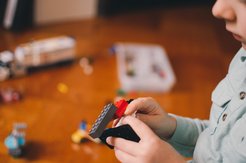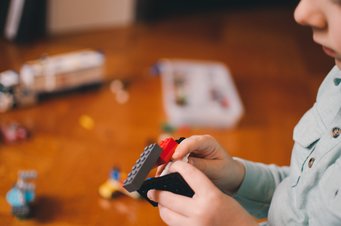Children compensate for lack of concentration through creativity
Study shows that children find their own solutions thanks to broad focus
Children have a hard time with concentration tasks, but are often good at discovering hidden "tricks" to make the task easier. Spontaneous strategy changes help them to do this, according to a study on learning behavior in children by the Max Planck Institute for Human Development in Berlin.

Compared to adults, children are not yet able to concentrate as well, remember less and their attention span is relatively short. This is due to the stage of cognitive development. As a result - so far assumed - they have a disadvantage when solving tasks. However, a study by the Max Planck Research Group "NeuroCode - Neural and Computational Basis of Learning, Memory and Decision Making" at the Max Planck Institute for Human Development now shows that the broader attentional focus can also prove to be an advantage: children are good at processing less relevant information and using it to spontaneously find new and creative strategies when solving tasks.
Adults, too, show spontaneous strategy changes when solving tasks, similar to so-called "aha-moments" that make solving a task easier. The journal article, published in the journal PloS ONE, shows that while children perform significantly worse when solving tasks using traditional strategies, such as focused attention, they are just as likely as adults to master tasks using spontaneous strategy shifts.
"Our results show that while children are often less focused and more easily distracted than adults, they are surprisingly flexible in discovering entirely new solutions," says psychologist and neuroscientist Nicolas Schuck, group leader of the Max Planck Research Group "NeuroCode" at the Max Planck Institute for Human Development. "Especially considering their not fully developed ability to concentrate, these are important results for researching learning behavior in children," Schuck added.
The study, which has been ongoing since 2013, used the following method to conduct research: 47 children between the ages of 8 and 10 and 39 young adults between the ages of 20 and 35 were asked to perform the same decision-making task. In this task, they were asked to determine the position of a pattern using two possible answers. The color of the pattern was not initially relevant to the correct answer, but began to be associated with the correct answer as the task progressed. When participants noticed this, they were able to solve the task much more efficiently and easily. The participants were not informed that there would be other factors influencing the possible solution strategies and could only identify them independently. The NeuroCode team at MPIB, in collaboration with researchers from Goethe University Frankfurt am Main, FernUniversität Hagen, Humbold University Berlin, UNSW Sydney, and PFH Göttingen, was able to achieve the following results: Compared to the young adults, the children generally performed significantly worse in solving the task. They had more incorrect and premature answers. However, the proportion of children (27.5%) who discovered and used the helpful color strategy was very similar to that of the young adults (28.2%).
As long as children only used the initial strategies and rules available, which required concentration and persistence, they performed worse. However, just as many children as young adults discovered and used the color rule. Thus, although children performed worse in all areas of cognitive control, an almost equal proportion of them compared to the young adults were able to improve through an "aha moment", and thus gained a similar performance advantage as the adult group.
The newfound knowledge around the "aha moment" is an important finding of the study. "Our findings provide evidence that educators, parents, and teachers should be less insistent on rigid rules, and only teach the one concrete way to solve problems, but also value and encourage children's broader attentional focus. Our findings show: We can have more confidence in children's creative problem-solving strategies," says Anika Löwe of the NeuroCode team and co-author of the study. In the future, she says, in the field of cognitive developmental psychology, there should be more research on creative processes rather than on lack of concentration in children.












